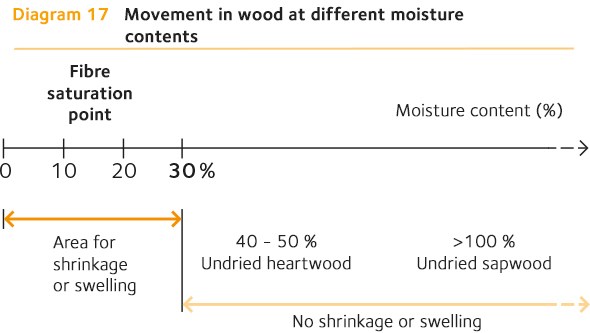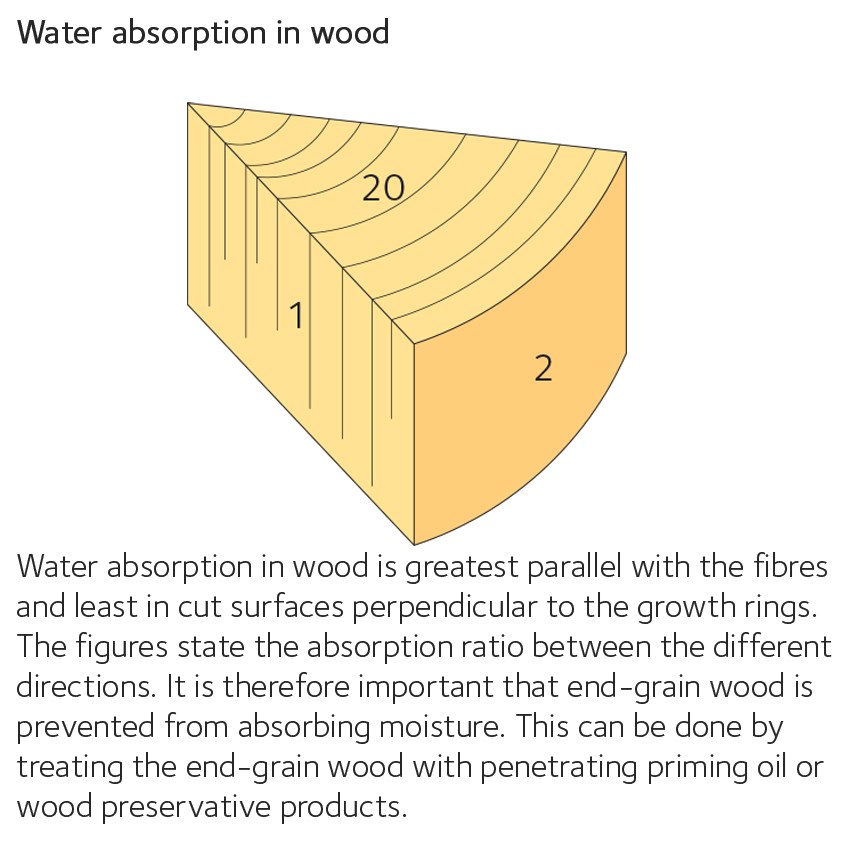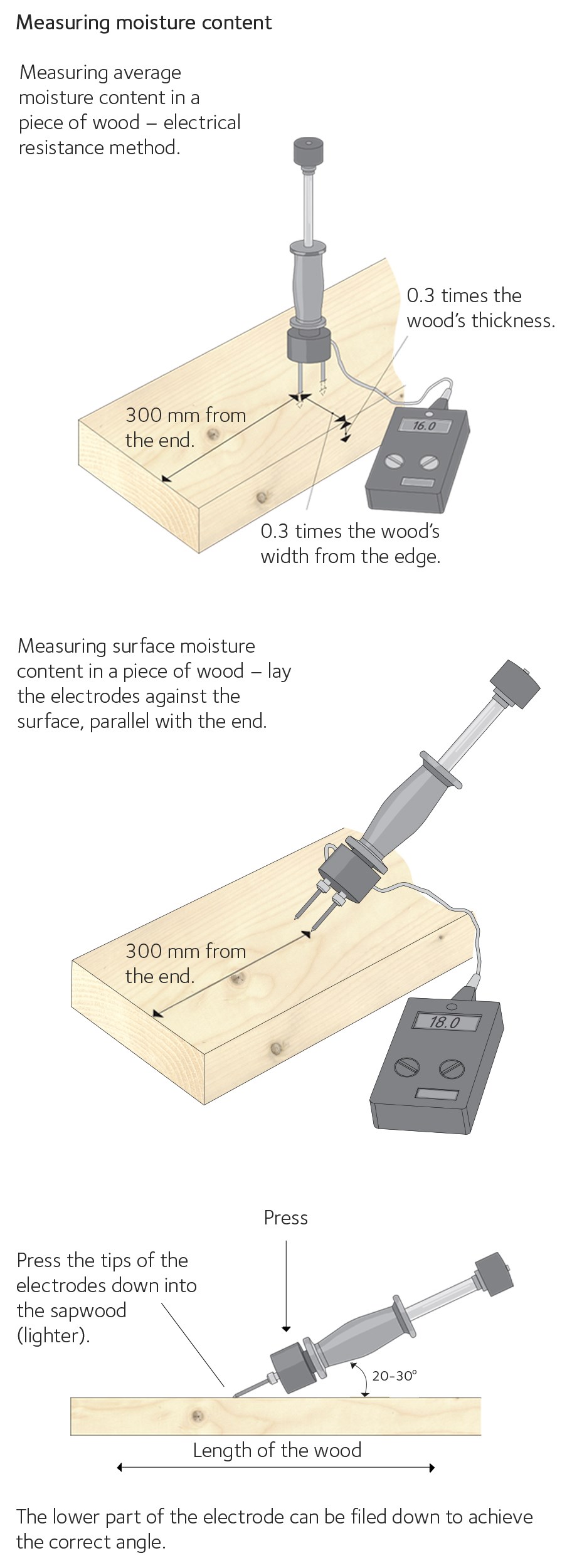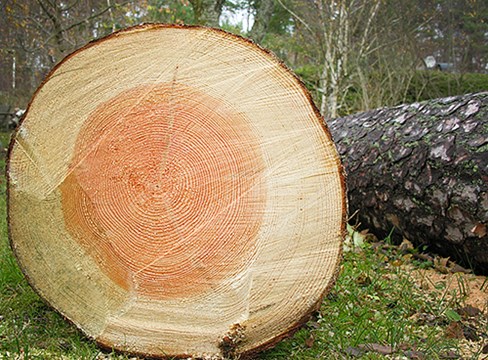Moisture content
Wood is a hygroscopic construction material. This means that the material monitors the surrounding air humidity and temperature and constantly strives to remain in equilibrium with the local climate, i.e. the relative humidity (RH) and the temperature.
The moisture (water) content in the wood is defined as the weight of the water in damp material divided by the weight of the material in a dry state. To obtain a percentage, the result is multiplied by 100.

The equilibrium moisture content is the moisture content that the wood has when it is in equilibrium with the local climate.
If the wood’s moisture content is higher than the equilibrium moisture content, the wood will dry out and if it is lower the wood will take on moisture. When the moisture content changes, below the fibre saturation point, the wood will therefore change its volume, depending on whether moisture is being released or absorbed – the wood swells or shrinks accordingly.
Dimensions, strength and resistance to decay are examples of key properties of wood that are affected by the moisture content.
Relative humidity and vapour concentration
Relative humidity (RH) may also be referred to as “relative air humidity” or “relative humidity in air”.
The air’s content of water vapour, its vapour concentration, is stated in grams water/cubic metre air and it varies over the year. Vapour concentration outdoors is at its highest in summer (9–11 grams per cubic metre) and lowest in winter (3–5 grams per cubic metre) – while RH and thus wood’s equilibrium moisture content is lowest in summer (65–75 percent and 11–15 percent respectively) and highest in winter (90–95 percent and 19–23 percent respectively). As described in the section Surface treatment of external wood, wood should have a surface moisture content of max 16 percent if being given surface treatment. Painting outdoors should preferably take place in May–August, but it is important to check the surface moisture content and the moisture content of the wood, for example with an electrical resistance moisture meter with insulated hammer electrodes.
Physically, the RH figure lies between the water vapour’s partial pressure and its saturation pressure at the temperature in question. The relative humidity of the air indoors in a heated room is therefore highest in summer (45–60 percent) and lowest in winter (10–25 percent). The colder it is outdoors, the drier the air indoors. The moisture content in wood, both indoors and out, adapts to the RH and temperature of its surroundings. In heated Swedish homes in mid Sweden, the moisture content in wood averages out across the year at 7.5 percent, with the highest figures in summer (7–12 percent) and the lowest in winter (2–6 percent). On average, it is drier in the north of Sweden than it is in the south, see diagram 15.
Target moisture content
Undried, newly sawn timber is usually dried to a particular target moisture content in the sawmills’ drying kilns. Target moisture content describes the desired average moisture content for a batch of wood and the allowable moisture content of the individual pieces in the batch. It is defined in standard SS-EN 14298. Each piece of wood in a batch is unique and is affected differently by the drying, depending on its density, resins, storage time before drying, sawing pattern, green moisture content and so on. This means that the individual pieces in a batch of wood will have a certain range of moisture content figures, which are combined to form an average value – the average moisture content for the batch. When ordering wood with a target moisture content of 16 percent, it would naturally be desirable for the average moisture content of the batch to be 16 percent – and ideally for all the pieces in the batch to have a moisture content of 16 percent. However, this is almost impossible. The average moisture content of a batch and the moisture content of the individual pieces are therefore allowed a certain range of variation for orders of a specific target moisture content in line with table 16, which is part of the standard SS-EN 14298.
Table 16 Target moisture content
Allowable variation for the average moisture content in line with SS-EN 14298
| Ordered moisture content (target moisture content) | Allowable variation in average moisture content for wood batch | Allowable range for the moisture content in 93.5 percent of the pieces in the batch | ||
| % | Lower limit (%) | Upper limit (%) | Lower limit (%) | Upper limit (%) |
| 8 | 7 | 9 | 5,6 | 10,4 |
| 12 | 10,5 | 13,5 | 8,4 | 15,6 |
| 16 | 13,5 | 18 | 11,2 | 20,8 |
When measuring the moisture content of all the pieces in a batch with a target moisture content of 16%, the average value for the moisture content of the whole batch (average moisture content) is allowed to fall between 13.5% and 18% to be approved. As regards the individual pieces in a batch, the moisture content of 93.5 percent of these must fall between 11.2% and 20.8%.
Moisture content’s variation in the wood’s cross-section
The moisture content doesn’t just vary between individual pieces in a batch of wood – it also varies in the cross-section of a piece. When wood dries, it occurs from the outside in. If no special measures are taken, the inner part of the wood will therefore be much damper than its surface after drying at the sawmill. This difference in moisture content in the wood’s cross-section is called the moisture gradient. See the section Sawmill conditioned wood.
When wood has been dried down to 16 percent in a kiln, the surface of the wood becomes very dry, often 6–7 percent moisture content, while the moisture content in the middle of the wood may lie at around 19–22 percent. Depending on the time between drying and packaging, the outdoor temperature and relative humidity (RH), this difference in moisture content will remain in place to a greater or lesser degree. The low surface moisture content provides good protection against microbial growth. See the section Microorganisms. It is therefore always important to check the surface moisture content.
The evening out of the moisture gradient often takes a long time. If the wood is kept in interim storage, unpackaged, for a prolonged period, the surface moisture content may end up being high, however.
When a piece of wood has its moisture content measured, this is in fact a value for the average moisture content of the cross-section. The average moisture content of the wood can be measured in two ways. A very accurate way is to first weigh a piece of wood, then dry it in a kiln at 103°C and weigh the fully dried wood again, in accordance with SS-EN 13183-1.
A more practical, but not as accurate, method is to use an electrical resistance moisture meter with insulated hammer electrodes, and to measure at a specific point and at a depth of 0.3 times the wood’s thickness. This measurement is considered to be representative of the cross-section’s average moisture content. See the section Measuring average moisture content and surface moisture content below.
A low moisture gradient is an important quality factor in preventing uneven shrinkage and bowing, for example.
Sawmill conditioned wood
Discrepancies between the average moisture content in a batch of wood and the target moisture content are difficult to reduce. Some improvement can be achieved by using good drying kilns and controlling them carefully, and by conditioning the wood after the drying process. It is, however, easier to reduce the moisture content range via conditioning at a high temperature after drying.
The moisture gradient in the cross-section of the wood and the drying stresses in the wood can be reduced with conditioning.
Conditioning also improves the wood’s dimensional stability. Wood that is to be split at a later stage should therefore have the stresses and moisture content evened out in the cross-section. This also reduces the risk that a finished wood product will gradually distort after the drying process. Distortions caused by drying stresses can be measured in line with the standard SS-ENV 14464.
As customers’ quality requirements increase, the sawmill industry will be more clearly specifying/stating the wood’s drying quality, not least with the help of the new standards. It will soon be possible to specify the quality of a batch of wood in terms of:
- Deviation from the target moisture content
- The moisture content range in the batch
- Drying stresses (drying quality)
A rule of thumb is that if the wood has low drying stresses, the moisture content range also tends to be low.
For the joinery industry, for example, conditioned wood products are necessary in order to achieve high quality joinery products (fewer gradual deformations).
In addition to having the right target moisture content, construction timber is also improved if the above quality parameters are used. Floor joists and structural timber, for example, become more dimensionally stable if evenly stressed wood is used.
When buying a batch of wood, a narrow variation in the moisture content range is just as important as the batch’s average moisture content being close to the target moisture content. A reduced variation in the moisture content, by conditioning the wood as part of the drying process, also means that the stresses in the wood will be evened out. This makes the wood more dimensionally stable and makes certain joinery products easier to manufacture.

Measuring average moisture content and surface moisture content
Checking the moisture content in wood involves measuring the level at different points in the structure in question. The measuring points are determined by conditions on site. Seek out the place where the risk of damp is greatest and drying conditions poorest.
Average moisture content
To measure the average moisture content in wood, random tests on a number of pieces of wood should be conducted with an electrical resistance moisture meter with insulated hammer electrodes, to gain an indication as to whether the right moisture content has been delivered. The average moisture content of wood is measured in line with SS-EN 13183-2 as follows: measure 300 mm from the end. Insert the insulated hammer electrodes into the flat face of the wood, in the direction of the fibres, and along an imaginary line running 0.3 times the width of the wood in from the edge. The measurement depth should be 0.3 times the thickness of the wood.
It should be noted that measuring the moisture content with an electrical resistance moisture meter with insulated hammer electrodes is not an exact method, and comes with a degree of uncertainty, depending on the measuring instrument’s quality and calibration. The method is, however, an effective way to get an idea of any deviations if correctly used. Regularly calibrate the moisture meter using a calibration block. A more precise method is the aforementioned dry weight method, which can be useful for production and delivery controls, but it is not a practical method of measurement on a construction site, for example.
To ensure that everyone measures moisture content and drying stresses in wood in the same way, there are now four standards:
SS-EN 13183-1 Moisture content of a piece of sawn timber. Determination by oven dry method, SS-EN 13183-2 Moisture content of a piece of sawn timber. Estimation by electrical resistance method, SS-EN 13183-3 Moisture content of a piece of sawn timber. Estimation by capacitance method, and SS-ENV 14464 Sawn timber. Method for assessment of case-hardening.
Surface moisture content
Measure the surface moisture content with an electrical resistance moisture meter by pressing the conical tips of the insulated hammer electrodes down into the springwood of the surface by hand, so that half the electrode tip makes an impression in the wood, going across the grain. Always take three measurements close to each other at the measuring point and then work out an average. The average can then be checked against the relevant requirement.
It is important to check the surface moisture content before encasing the wood, since it is crucial in determining the risk of microbial growth. It also has an impact on the adhesion of paint.
The wood may have become damp due to rain, incorrect storage or the wood being placed in contact with damp concrete, giving it an elevated surface moisture content. The moisture content in the inner part of the wood will not normally be affected by short-term exposure to damp. Wood that has become damp must be dried – naturally, with a dehumidifier or with a construction fan – and the surface moisture content should be max 18 percent prior to it being encased.
Wood that is to be painted on the construction site should be primed as quickly as possible to protect against UV radiation, and the surface moisture content should be max 16 percent when painting. It is recommended that exposed wood such as external cladding and interior cladding should be industrially surface treated with a film thickness for the primer of at least 60 μm (micrometres) as a dry layer.
Note
There is no standard for measuring the surface moisture content of wood.
Table 18 Target moisture content for deliveries of wood products for different applications
| Target moisture content (%) | Application |
| 8 | Floorboards indoors in heated rooms |
| 12 | Exposed cladding, mouldings and subfloors in heated rooms |
| 16 | Solid wood and glulam for encasing and exterior cladding |
Acceptance check of drying quality
Acceptance checks have also been standardised. Two standards are used for this purpose:
SIS-CEN TS 12169 Criteria for the assessment of conformity of a lot of sawn timber.
SS-EN 14298 Sawn timber. Assessment of drying quality.
SIS-CEN TS 12169 describes how samples from a batch of wood are to be selected to check whether the ordered drying quality (average moisture content in a batch, moisture content range and drying stresses) has been delivered as per the contract or building specification. The method is based around the use of the most common control method for all industries, Acceptable Quality Level (AQL). An acceptance check involves randomly selecting a set number of sample boards or planks, depending on how many boards or planks are contained in the batch. The standard sets out what deviations are allowable, depending on the chosen quality level.
Note
The whole content of the wood package must be made available in the event of a complaint.

 Tomtebo forest sauna, Gävle, winner of the Swedish Timber Prize 2012. Architect: Meter Arkitektur, Bengt Mattias Carlsson.
Tomtebo forest sauna, Gävle, winner of the Swedish Timber Prize 2012. Architect: Meter Arkitektur, Bengt Mattias Carlsson.



